|
| |
|

|
|
|
| july - september 2004 | focus on film 12 | |
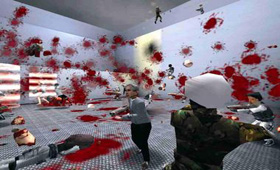
Off_Corso. Diplomatic Arena. Interactive Instalation 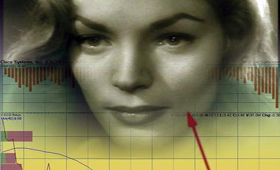
Rotterdamse Schouwburg. Dead Cat Bounce, performance 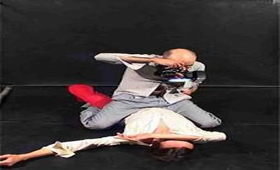
TENT. Slave Unit, Cel Crabeels, video - instalation, 2003 
Centrum Beeldende Kunst. Tonight so Lovely, Cai Guo - Qiang, 2 videos, 2001 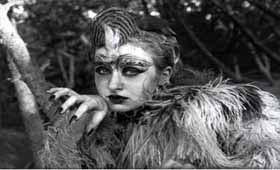
Witte de With. Blue Sailor, Ulrike Ottinger, photography 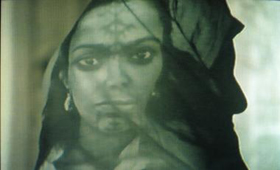
Museo Boijmans van Beuningen. Frantz Fanon, Isaac Julien, film 35 mm, 1996 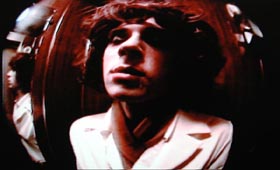
RAM. Body Double I, Brice Dellsperger, 1995 |
| review |
|
||
| Exploding Cinema by Adriana Schmorak In the program of Exploding Cinema: Power: Play, a series of exhibitions related to the Rotterdam International Film Festival was developed. Photographs, video games, videoart and performances were exhibited in spaces especially offered by art galleries, museums and centers in one of the most important and modern port cities of the world for the ten days of the Festival. Bistart was there and shares this summary with its readers. |
|
||
| OFF_CORSO Kruiskade 22, Rotterdam www.filmfestivalrotterdam.com During the ten days of the Festival, the dance Pub, Off_Corso, turned into a Fight Club, where visitors could actively participate in the works, witness the performances and demonstrations and explore the political potential of the game, which was mainly inspired by current international circumstances (the attack on the Twin Towers, the War in Afghanistan, the Gulf War, the conflicts in the Middle East…) and the televised broadcast of these events. For this, Off_Corso showcased a selection of over 20 web pages, consoles and installations. For the past two decades, computer games have become the directors of new image technologies. Filmmakers, designers, script writers and television producers have been borrowing the novel form of this new language, while artists have been turning to this media to express their ideas. In the Waco Resurrection installation, the player has to identify himself with the leader of the Davidian sect, David Koresh. According to C-Level, creators of this interactive installation, the games offer a new way of making documentaries subjective. Other exhibitors were: Virtual World of Art, Anne-Marie Schleiner, Marcus Kirsch, Apart, Cory Arcangel/BEIGE, MAMA gallery and Superflex. ROTTERDAMSE SCHOUWBURG Schouwburgplein 25, Rotterdam www.schouwburg.rotterdam.nl There is an economic phenomenon that challenges the laws of logic: the securities market. Greed, the fear of losing, collective hysteria, rumors and simple hunches rule this world of high finances. Artist Christopher Kondek included the constant fluctuations of Wall Street in his experimental theater piece titled Dead Cat Bounce, which opened worldwide at the Rotterdam Festival. The Rotterdamse Schouwburg Center was connected live with the New York Stock Exchange through an Internet account that was part of a network of stock transactions. By using box office proceeds every night to buy and sell stock, Dead Cat Bounce attempted to explore a new concept with the increasingly committed participation of the audience in theater pieces. By investing (literally speaking) money in the performance, the audience became part of the unstable universe of buying and selling commercial papers, of the game of chance which is the Stock Market. The title of the performance was taken from an article written by Chet Currier, published by The Associated Press, which sarcastically describes the fluctuations of oil stock prices: “If you throw a dead cat from a 50-year-old building, it may bounce when it hits the sidewalk. But don·t confuse this bounce with renewed life. It·s still a dead cat.” TENT Witte de Withstraat 50, Rotterdam www.tentplaza.nl Tent presented, under the title Friendly Fire, a collective show with video installations, video games, performances and photographs to illustrate the central theme of this year·s Exploding Cinema program. Friendly Fire reflects upon the phenomenon of video games and their effects on how we perceive reality. The underlying theme is the increasing overlapping of games and the news, which began with the first Gulf War and evolved during its recent improved version. The artists installed a real game field for this bodiless electronic world, in which battles are virtually represented based on a player-spectator. Slave Unit Cel Crabeels, Belgium, 2002, video installation. Slave unit is a photographic piece with a sensor installed in the camera. This device is sensitive to flashes and can detect when a snapshot is taken, indicating the degree of intensity of the flash. In Cel Crabeels· video, the artist uses this same idea and applies it to a broader concept: the relationship between dominant and subordinate figures. The piece is a cross between dance, photography and video installation, in which a man and a woman alternate between being dominating to being dominated taking photographs of each other with a potent and blinding flash. Precisely when the slave unit is activated, the photographer – master becomes a model - slave and vice versa. EXistenZ props David Cronenberg, Canada, 2000, objects This exhibition is based on the film of the same name Cronenberg made in 1999 about a designer that creates a virtual reality game that is so perfect it turns into an adventure where it is hard to tell reality from fiction. In many of his films, Canadian director David Cronenberg, assigns a prevailing role to the props, objects that are used on film sets and theater stages, especially designed by him to provoke a specific reaction in the main characters. In comparison to his gynecological instruments (Dead Ringers, 1988), his insect-shaped typewriters (Naked Lunch, 1991) and his prosthesis – fetish (Crash, 1996), these objects, designed for eXistenZ seem the most organic, almost like independent life forms. With strange names such as Medusa, Viral Ecstasy, Cyst or Biological Father, the metaphysical questions evidenced by Cronenberg in his films are found in the smallest details of his game consoles and his objects. Natural Mystic (Tomahawk # 2) Anri Sala, France, 2003, video installation At first sight, Anri Sala·s work looks like a luxurious display of an installation consisting of a crystal liquid display mounted on a shiny metallic easel. Everything seems perfect and high tech. However, through the headphones a screeching and dissonant sound can be heard that seems to come from far away, getting closer and closer until it becomes unbearable. Then it starts to fade until it becomes a murmur. Projected on the screen there is a musician in a recording studio. Musical instruments, drums, keyboard, everything surrounds him, but he only whistles into the microphone. This piece reflects the memories of war that remain in a man·s mind, without making any specific affirmations nor giving easy answers about the violent reality of the world today. Afghani War Carpets Hans Werner Mohm Collection, Afghanistan/Germany. In Western pop culture, computer games provide the most detailed information on recent wars, while, in other parts of the world, military high tech is viewed from a more traditional perspective. Carpets have always been one of the main ways of telling stories in Afghanistan. In the past, carpets illustrated symbols of life, today they have become symbols of death. In these traditional illustrations, war scenes are depicted with helicopters, planes, troops and Mujaidines in the plains and mountains with representations of towns and cities surrounded by tanks. What is interesting is that the way these carpets have been woven is similar to the pixeled images of the first computer games. The House of Osama bin Laden Ben Langlands and Nikki Bell, United Kingdom, 2003, multimedia installation. The House of Osama bin Laden is a multimedia installation made with the funds of a research grant awarded by the Imperial War Museum of London. The artists traveled to Afghanistan and conducted an exhaustive research of the last house which was Osama bin Laden·s official address. In this piece, the audience could explore the same environment digitally created in 3D graphics. To do this, the artists also added takes of the place, photographic images of traffic signs, and a series of false flags. Taken as a whole, the installation turned into a shooting simulator for a puzzle-like video game, involving strategy, logic and sequence resolution. It is a piece rich in references and very elegantly designed. In the Field of Players Jeanne van Heeswijk and Marten Winters, Holland, 2004, performance. The main section of the TENT Center is normally called “square” because the building was used as a school, and the area was originally a play area. Winters and Van Heeswijk added colored lines and surfaces to this space for their performance. As in a sports arena, these lines had no other purpose than to be used by the players. The relationship between those players developing according to the rules of the game and the growing tension have to do with social relationships between humans that emerge during the game, the audience being the one who defines the underlying reality of the players and their implicit rules. Q-Q-Q Nullpointer, United Kingdom, 2003, video game This is a project based on the growing practice of altering the game. The users· interface software is modified to distort the players· perception of this delirious space and to turn it into a pure experience of vertigo. Modifying the code for graphics and audio, the piece subverts the function of the program. The digital game field is manipulated with programming techniques to produce abstract architectural shapes. Real time of the game sessions is represented in a different cultural context, while people who participate on-line act as invisible players. Contextually changed, their actions and interactions are turned into a performance with live participation. Baltimore Isaac Julien, United Kingdom, 2003, video – triptych Baltimore includes a series of photographs, a wax statue and the projection of a color video on three screens. Shot in two museums of Baltimore, this new work pays homage to the so-called blaxploitation genre started in the ·70s. Melvin Van Peebles, pioneer of this new genre focused on the topic of social exploitation of African American men and women, wrote, directed, edited and acted in the 1971 film “Sweet Sweetback`s Baadassss Song”. Julian·s work represents culture shock with the simultaneous projection on different screens in two spaces of the museums: the Wax Museum and the Walters Art Museum, where the figure of African Americans appears hidden in the white space of the classic museum. Baltimore uses high-tech special effects to create a narrative cycle in which Van Peebles follows a cyber character who, at the same time, is following him. CENTRUM BEELDENDE KUNST Nieuwe Binnenweg 75, Rotterdam www.cbk.rotterdam.nl With the title Tonight So Lovely, Chinese artist Cai Guo-Qiang, exhibited two videos simultaneously of the Fire Works in Shanghai at the opening of the Asia Pacific Conference (APEC) in October 2001. This video installation has two parts: the first one was broadcast live by the local television station under the theme: Beautiful Tonight and represents the official point of view with an evident style, from camera angles to the editing of the music and voices in off emanating beauty, great luster and idealism. From the coverage of the Oriental television, it was easy to see how each art form can be incorporated into politics. Cai Guo-Qiang, on the other hand, edited a different version, presenting the background hidden from the public, an unofficial view consisting of more realistic camera angles to such a point that the explosions and the gun powder-charged atmosphere are more similar to a fire or a bombing than a celebration. Since the show took place just one month after the Twin Towers were attacked, the security systems in China were reinforced to such a point that the public was not allowed to be present at the show, certain products that were going to be used were eliminated and some segments of the show were cancelled. The streets were deserted because the public was forced to watch the celebrations in their homes, and it turned into an event for dignitaries from other parts of the world, among who was George W. Bush. Cai believes that his gap between the original design with computerized operating systems and the uncontrollable finale taken directly by him, is where the artistic value of the piece is found. WITTE DE WITH Contemporary Art Center Witte de Withstraat 63, Rotterdam www.wdw.nl Bild Archive Ulrike Ottinger Ulrike Ottinger (1942) is one of the most provocative and unique filmmakers in Germany. He first experimented with paint, works on paper, photography and performances. Since his debut in the ·70s, he has made more than 15 expressionist films and experimental documentaries. Bild Archive is a retrospective of his photographs and first movies such as Usinimage (1987) or the more recent Southeast Passage (2002). This succession of images (photographs, post cards, cutouts, illustrations and iconographic documents), make up an open archive of a life and a body of work based on the principle of a collage of images and events. In this manner, Ottinger presents to the audience the complex relationship between his work and the world, history and culture. Under Fire Jordan Crandall Under Fire is a one-year project in which Jordan Crandall explores the organization and representation of current armed conflicts, which he considers are governed by a combination of territorial, economic and ideological interests that threaten the conciliation of different cultures and universalism. The project is made up of a series of organized debates which will take place all 2004 on the Internet and in the city of Rotterdam, between the public, politicians, theoreticians, critics, artists and journalists from countries in the West and the Middle East, with the intention of creating new historical perspectives and exploring the potential of Islamic discourse as a source of political and critical debate. There will also be a series of publications edited during the year. Each of these publications is organized around a concept that acts as an interpretive key that emerged from the discussions. By using this approach, Under Fire aims at collaborating in the opening of a discursive arena that offers new perspectives to the problem of the war and alternatives to its perpetuation. . BOIJMANS VAN BEUNINGEN MUSEUM Museumpark 18-20, Rotterdam www.boijmans.nl Paradise Omeros Isaac Julien, 2002, triple DVD projection Three Isaac Julien, 1996-1999, DVD projection Before Paradise Isaac Julien, 2002, photographs Frantz Fanon, Black Skin, White Mask Isaac Julien, 1996, DVD projection British artist, Isaac Julien (1960), was chosen as one of the in-focus artists at the 2004 Rotterdam Film Festival. With this selection, officials of the Festival and the Boijmans van Beuningen Museum underline the current importance of the dialogue between film and visual arts. Isaac Julien started out as a filmmaker, but for the last two years he has been working mainly on video installations. These are spatial installations in which the physical relationship between the observer and the projected image are questioned and tested. His works not only illustrate a mixture of genres (documentaries, fiction, experimental film), but also a special interest in non-linear stories edited and mounted in very complex and novel ways. Julien uses conventional devices such as classic narrative lines, leading and supporting actors and principles of superproductions that he later translates into unconventional formats. His films are based on the subject of class-consciousness, gender and the immigration from former colonies to so-called First World countries. For instance, in Paradise Omeros a young man from the Caribbean moves from the island of Santa Lucia to a cold and unpleasant London in the 1950s. It is a piece that explores the expressive possibilities of bodies dancing on three screens that make up this cinematographic triptych, a format that is in perfect harmony with the museum hall. RAM Blekerstraat 10, Rotterdam www.ram-art.nl Photograms Catherine Breillat. RAM exhibited over 30 photograms especially chosen by Catherine Breillat from her new film Anatomie de l´Enfer, which premiered worldwide at the Rotterdam Film Festival. In her 10th movie, Breillat took a closer look at the topic of her film Romance and this way ended a Decalogue that intensely explores the most intimate relationship between a man and a woman. The frozen moments represented in these photograms, with actors Amira Casar and Rocco Siffredi beautifully captured by cameraman Yorgos Arvanitis, are fragments of an erotic meeting. By transferring these images from celluloid to the gallery, Breillat has given them a different life, she has created a peculiar collection of objects liberated from their original narrative. Videotrafic 15 French artists Less promoted were the pieces projected in the Video Room of the RAM gallery. Under the title Videotrafic, 15 young video artists presented their most recent works. Some of them were: Boris Achour, whose short film Un monde qui s´accorde à nos désirs (2000) is a take of a glass overflowing with milk in a process that was shot on 35 mm with 150 images per second; Kim Sop Boninsegni with Entropic song - a non-language (2001) where this Korean artist reviews the images of Asia within the context of economic crisis, globalization, consumerism and young people·s loss of traditional values; Ange Leccia with Égypte (1999) where frozen, then accelerated images with their moments of silence and music, calm and violence stand out; Abel Abdessemed in Mens Moi (1995) shows a war documentary which soon turns into a sequence of fireworks, the title Miénteme refers to the ambiguity in the broadcasting of world events; Laetitia Benat presented Total Radiance (2001) in which the artist varies the duration of the scenes, uses subexposed and blurred photographs, going from general distances to foregrounds even cutting the figure in the frame and saturating the colors, among other experimental techniques; Bernard Joisten with Les Aventures (2000) presented a short film made with narrative motifs and atmospheres inspired by silent movies. Other works were: Préliminaires (1999) by Rébecca Bournigault, Générique by Franck David, Body Double 1 (1995) by Brice Dellsperger, I wanna be – the slit (2001) by Marina Faust, You and me (1998) by Jean-Luc Vilmouth, Kuala Zone (2002) by Christelle Lhereux, Masume is a PC operator (2001) by Apichatpong Weerasethakul, Transfert (1998) by Anne Fermi and Freddy (1999) by Georges Tony Stoll. They all share the common need of new artists to experiment with the most modern image technologies that rule this Digital Era, and where images of external reality are no longer captured analogically but by manipulating and, thus, modifying the work subjectively and creatively. They often try to use the material taken with traditional devices as in movies, video and photography, to later modify them with the use of computers. The title Videotrafic precisely refers to this new reality: that of the traffic of visual signs that are translated into virtual images, experimental video, video clips, video games that are later broadcast over the Internet, state-of-the-art cell phones, or material reproduced on computers or equipment able to read digitized images and sound, as in the case of DVDs and CDs. Movement of the image no longer depicts the story it tells, rather, it is the succession, overlapping and treatment of the image with an aim that is almost purely aesthetic that stimulates the audience·s mind, an audience that increasingly participates and is less contemplative. |
|
||
| |
|||
|
magazine
|
gallery
|
guide
|
online projects
|
info
|
newsletter
|
contact us
|